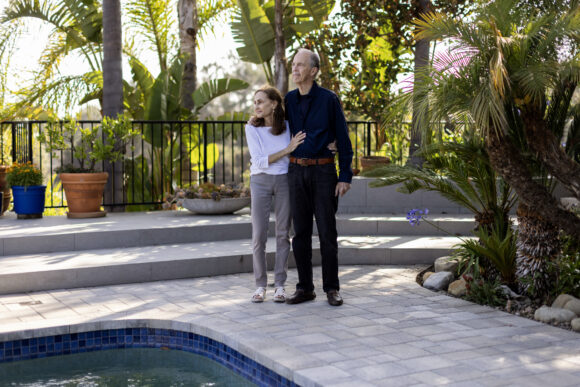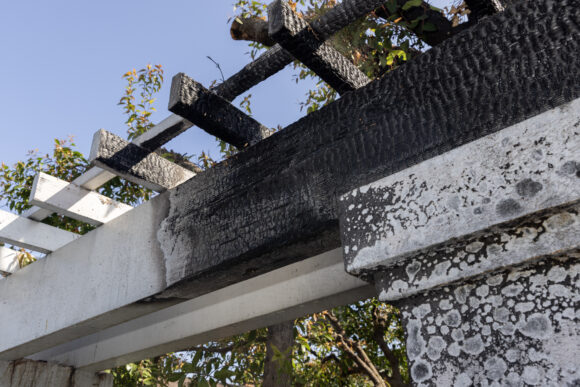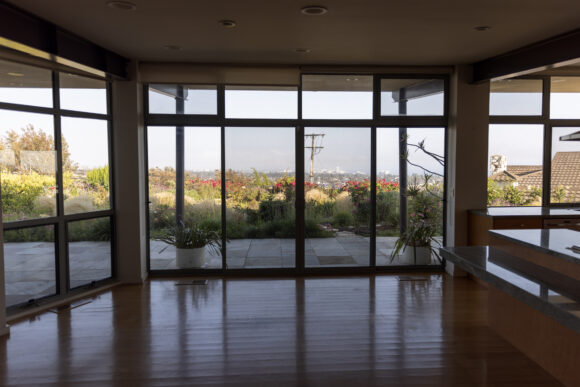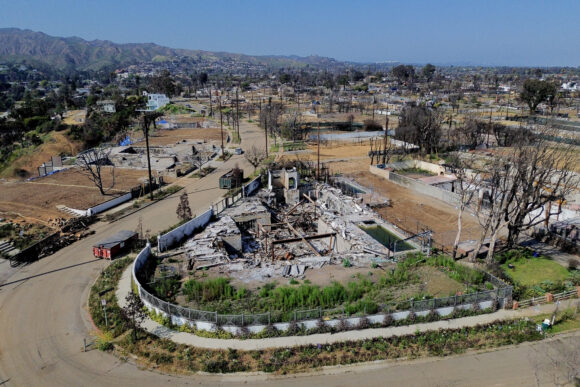Months after fireplace tore via Los Angeles’ Pacific Palisades neighborhood, owners are struggling to get reimbursed — not for homes diminished to rubble, however for the harm of smoke and toxins within the properties that stay.
For residents similar to Keri Homolka, combating for a payout has grow to be a full-time job. The Jan. 7 blaze brought about the window frames of her house to buckle and crack. Paint on the partitions bubbled. Whereas the residence was spared from whole destruction, its insides had been tarnished by ash and soot, residue from the burned-out homes on both facet.
Associated: Local weather Group Says State Farm Charge Hike to Value California Owners $1,000
The 76-year-old retiree and her husband, who’ve owned the house since 1999, spent greater than $100,000 on testing, cleanup, lodge stays and repairs after discovering elevated lead ranges within the mud. Homolka mentioned their insurer, California’s FAIR Plan, has paid simply $15,000 of their declare.
“We’re bleeding cash,” she mentioned. “We’re again in our house, nevertheless it’s simply not truthful. You pay all this cash for insurance coverage, after which it’s nothing.”

Though their houses may nonetheless be standing, many victims of the January fires now discover themselves navigating comparable insurance coverage ordeals, from expensive and time-consuming delays to outright declare denials. Whereas a number of insurance coverage suppliers have been the topic of complaints, the California FAIR Plan is beneath explicit scrutiny. The state’s insurer of final resort is dealing with an investigation by the California Division of Insurance coverage in addition to lawsuits from policyholders.
As of Could, the Division of Insurance coverage’s shopper providers division had acquired about 120 complaints relating to FAIR’s dealing with of smoke harm claims associated to the LA-area wildfires. The scenario is so tough that some owners say they want their home had merely burned down, mentioned Michael Soller, the division’s deputy commissioner of communications.
Associated: Owners Suing USAA and AAA Insurers Over LA Wildfires
“That’s a horrible place to be,” he mentioned.
The wildfires have positioned in stark reduction the challenges of barebones insurance coverage insurance policies at a time when conventional insurers are pulling again from areas liable to local weather disasters. The FAIR Plan accepts properties that non-public insurers have deemed too dangerous to cowl.
FAIR Plan insurance policies grew by 85% final 12 months in a ZIP code central to Pacific Palisades. In that very same space, State Farm, California’s largest insurer, reduce practically 70% of its insurance policies, together with Homolka’s.

The Division of Insurance coverage earlier this month launched a separate probe into State Farm’s dealing with of claims from the Palisades blaze and the Eaton Hearth, which practically leveled the group of Altadena northeast of Los Angeles. Among the many complaints filed to the insurance coverage commissioner are disputes over how the corporate is dealing with smoke harm claims, Soller mentioned.
In a June 12 assertion posted on its web site, State Farm mentioned it’s cooperating with the Division of Insurance coverage and can adjust to the company’s market conduct examination course of.
“A good evaluate will discover that 1000’s of State Farm clients are being helped by our groups on the bottom in Los Angeles County and are very glad,” the insurer mentioned.
As of Could, FAIR had acquired greater than 5,000 claims for damages brought on by the Eaton and Palisades fires, of which greater than half are reported as partial loss, together with smoke harm. The upper share of complaints have come from Pacific Palisades, given the plan’s dominance in that space. The plan mentioned that as of early Could it had paid $2.7 billion in claims, together with for smoke, tied to the blazes.
Final month, the Division of Insurance coverage despatched a letter to FAIR demanding that it amend its coverage and examine smoke harm claims pretty. The division has deemed FAIR’s coverage provisions as “void and unenforceable” as a result of they don’t present the minimal stage of protection as mandated by California regulation, in response to the letter.
“The language of their coverage type differs from each different insurance coverage firm and commonplace language,” Soller mentioned. “Placing individuals again in a house that isn’t secure just isn’t acceptable.”

The FAIR Plan says its insurance policies are according to different insurers, requiring direct bodily loss for there to be protection. The Division of Insurance coverage alleged in its letter that the plan’s coverage provisions for such losses use “slender definitions as a method to exclude protection for smoke claims.”
Elise Klein, FAIR’s chief authorized officer and basic counsel, mentioned in a response that the insurer disagrees with a few of the division’s claims and that it’s going to work to achieve an settlement on language about smoke protection.
“The FAIR Plan pays all lined claims, together with smoke claims, according to California regulation and its coverage varieties, that are accepted by the California Division of Insurance coverage,” mentioned Hilary McLean, a spokesperson.
Lead, Asbestos
Christian Rovsek runs ServiceFirst Restoration Inc., a contractor that has serviced smoke-damaged properties within the Palisades and Eaton fireplace areas, and mentioned nearly each home he’s examined for toxins has come again with findings of lead and asbestos.
These houses require particular cleansing and disposal protocols, he mentioned. That may contain the whole lot from eradicating attic insulation to duct cleansing and utilizing particular gear like air scrubbers, HEPA vacuums and chemical sponges. Remediation can value $50,000 to $100,000, he mentioned.
Rovsek mentioned his clients on the FAIR Plan battle to even get an adjuster on the cellphone, not to mention a declare paid. “It’s nearly as in the event that they’re not insured,” he mentioned. Consequently, he’s began providing his these shoppers a pared-back service that skips extra expensive measures like cleansing inside drawers and cupboards.
Some residents have seen higher outcomes. Kevin Minds’ Palisades house remains to be standing after each home throughout from his burned down. He has thus far acquired greater than $200,000 in reimbursements from his insurer, USAA, and expects to get extra.

Minds’ house suffered some effervescent on the roof and ash and soot all through. He paid Rovsek’s firm about $96,000 for remediation after testing revealed elevated ranges of lead, and is ready to shell out one other $20,000 as soon as his insurance coverage payout is accepted. He expects to pay a further $113,000 to have all of the gadgets in his house packed out and cleaned, in addition to upwards of $370,000 on a brand new roof, furnace and HVAC system, in addition to flooring, his pool, photo voltaic and landscaping. He’ll search reimbursement for as a lot as potential.
“I’m in fairly fine condition,” mentioned Minds, a 64-year-old aerospace engineer. “I’m not on the California FAIR Plan.”
Lawsuits in opposition to FAIR are mounting. J. Eli Wade-Scott, a world managing associate at Edelson PC, mentioned his agency, alongside co-counsel Kerley Schaffer LLP, at present represents greater than 100 shoppers from the Eaton and Palisades fires suing FAIR for its dealing with of smoke claims.
The lawsuits allege that FAIR makes use of unlawful coverage language to disclaim smoke harm claims, leading to failures to completely examine wildfire losses, check houses and property for poisonous smoke contamination and reimburse policyholders for vital assessments and repairs.
Setting Requirements
The Division of Insurance coverage is evaluating FAIR’s response to its letter and subsequent steps. Within the meantime, Commissioner Ricardo Lara has launched a activity drive to set requirements for inspecting, testing and remediating properties with smoke harm, in addition to figuring out which companies could be concerned in creating and implementing these requirements.
“Elected officers have to do one thing,” mentioned Philip de Vellis, 51, a political marketing consultant whose mom’s house in Pacific Palisades was broken. “It’s clear that the California FAIR Plan was not set as much as cope with a catastrophic scenario and repair it like they need to.”
De Vellis mentioned his mom, who died this month at age 87, was pressured on to the FAIR Plan when State Farm cancelled her coverage a number of months earlier than the blaze. Whereas her home survived, heavy winds and cracks within the windowpanes meant {that a} good portion of the inside was lined in poisonous ash.
Thus far, de Vellis has spent about $70,000 on remediation and having private gadgets cleaned. He additionally paid $15,000 a month for his mom to reside in an assisted dwelling facility close to his house in Washington, DC, earlier than she handed away. She acquired far much less — about $48,000 — in reimbursements from FAIR for dwelling bills and remediation, de Vellis mentioned. He needed to throw away most of her belongings, as a result of estimates to correctly clear them had been too excessive.
Homolka and her husband have since moved again into their house within the Palisades. To avoid wasting on bills, they opted to solely have the flooring, partitions, ceilings and cupboard fronts cleaned, slightly than having the whole lot in the home taken out and professionally remediated.
If FAIR “got here via with $25,000 or $30,000, we’d be overjoyed,” she mentioned. “However I doubt they’d.”
Prime photograph: Houses destroyed by the Palisades Hearth. Photographer: Roger Kisby/Bloomberg.
Copyright 2025 Bloomberg.
Subjects
Louisiana

